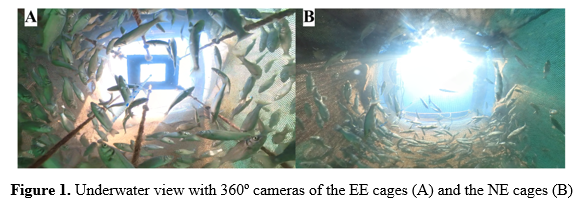POSITIVE BEHAVIORAL AND WELFARE EFFECTS OF STRUCTURAL ENRICHMENT ON CAPTIVE EUROPEAN SEABASS
Introduction
The increasing demand for protein by the human population has driven the growth of the aquaculture industry, with fish being the most widely farmed organisms. Nevertheless, captive conditions are often inadequate due to spatial uniformity, homogeneity, and the immutability of the environment. These conditions can impair the welfare and cognitive abilities of the fish 1,2. In this context, providing environmental enrichment (EE) is a well-established strategy to promote animal welfare by offering novel stimuli that support behavioral, physiological, and psychological needs 1,3. In aquatic species, structural EE, understood as the addition of physical complexity through objects or structural modifications 1, has been shown to reduce stress, enhance cognitive abilities, and mitigate abnormal behaviors 4–8. The effects of EE vary depending on the species and its life stage1,8. Despite the growing interest in the effects of this strategy in captive fish, there remains a significant lack of knowledge regarding some of the most relevant species for the industry, such as the European seabass (Dicentrarchus labrax, L.)3. Consequently, our aim was to analyze the effects of environmental stimulation through physical structures, considering behavioral, physiological, and cognitive aspects in European seabass, to assess their potential applications for improving welfare.
Material and Methods
The study was carried out in experimental facilities located in the coastal waters of Port of Andratx (Balearic Islands, Spain), belonging to the Laboratory of Marine Research and Aquaculture (LIMIA-IRFAP). A total of 4000 juvenile seabass of about 30 g in weight, were randomly distributed into 8 experimental marine sea-cages. Four of these sea-cages were structurally enriched, while the remaining four were kept bare, serving as the control (EE and NE cages, respectively). The applied structural EE consisted of a floating rectangular cork from which six knotted ropes with a weight at the end were suspended, occupying more than half of the vertical space within the sea-cage (1.5 m). The juvenile individuals were maintained under the influence of the treatments for approximately 3.5 months (03/11/2024 - 07/05/2024; 116 days).
After 2.5 months from the beginning of the enrichment period, the emotional reactivity test (ERT) was conducted over four consecutive days to evaluate the effects of structural EE on the behavioral response of seabass, testing ten individuals per marine sea-cage . For this behavioral test the fish was placed into a circular experimental tank (Ø 55 cm, 38 cm high) that it had never explored before (Open-field test). The researcher then leaved the vicinity, marking the start of the ERT, during which behavioral responses of each fish were recorded individually for 10 minutes with a top-view camera (GoProHero10®). At the end of the testing period all individuals were euthanized with an overdose of anesthetic and subsequently sampled . Muscle and telencephalon tissues were dissected and immediately frozen at –80 °C for subsequent analysis of oxidative status in the laboratory. The activity of three antioxidant enzymes [catalase (CAT), superoxide dismutase (SOD), and glutathione reductase (GRd) ] was quantified, along with the concentration of malondialdehyde (MDA), a compound commonly used as a marker of membrane phospholipid oxidation.
Results and Discussion
Results showed that fish reared under environmental enrichment displayed enhanced exploratory behavior, covering greater distances, and utilizing a larger area more uniformly across the available space. Furthermore, the day-to-day variations observed in the different parameters of the ERT in enriched fish were consistent with a normal habituation process to a novel environment, indicative of positive welfare. In contrast, control fish exhibited higher anxiety levels and lacked such habituation patterns. Overall, enriched fish demonstrated more active behavior and greater adaptability to unfamiliar situations, whereas non-enriched fish showed limited exploration and a more constrained response. Additionally, this behavioral pattern was associated with the activation of muscle enzymatic mechanisms that prevented oxidative damage, reflecting greater physiological resilience under challenging conditions. These findings highlight the role of EE in fostering positive welfare states in fish by promoting natural behaviors and reducing stress responses. The implementation of structural EE represents a promising, non-invasive approach to improving fish welfare in captivity or controlled environments, warranting further investigation and potential applications.
Acknowledgements
We would like to thank the staff, technicians, and researchers of LIMIA for their help and assistance during the process of the study, and for their facilities and resources in Port d’Andratx. We would also like to thank the staff of Aqüicultura Balear (ABSA, Culmarex Group) for their fish, help and assistance during the experiment.
References
1. Arechavala‐Lopez, P., Cabrera‐Álvarez, M. J., Maia, C. M. & Saraiva, J. L. Environmental enrichment in fish aquaculture: A review of fundamental and practical aspects. Rev. Aquac. 14, 704–728 (2022).
2. Korte, S. M., Olivier, B. & Koolhaas, J. M. A new animal welfare concept based on allostasis. Physiol. Behav. 92, 422–428 (2007).
3. Näslund, J. & Johnsson, J. I. Environmental enrichment for fish in captive environments: effects of physical structures and substrates. Fish Fish. 17, 1–30 (2016).
4. Batzina, A. & Karakatsouli, N. Is it the blue gravel substrate or only its blue color that improves growth and reduces aggressive behavior of gilthead seabream Sparus aurata? Aquac. Eng. 62, 49–53 (2014).
5. Oliveira, A. R. et al. Structural enrichment promotes natural behaviour and welfare of captive gilthead seabream broodstock. Appl. Anim. Behav. Sci. 275, 106289 (2024).
6. Cabrera-Álvarez, M. J. et al. Environmental enrichment reduces the effects of husbandry stressors in gilthead seabream broodstock. Aquac. Rep. 37, 102256 (2024).
7. Muñoz, L., Aspillaga, E., Palmer, M., Saraiva, J. L. & Arechavala-Lopez, P. Acoustic Telemetry: A Tool to Monitor Fish Swimming Behavior in Sea-Cage Aquaculture. Front. Mar. Sci. 7, 645 (2020).
8. Arechavala-Lopez, P. et al. Effects of structural environmental enrichment on welfare of juvenile seabream (Sparus aurata). Aquac. Rep. 15, 100224 (2019).
